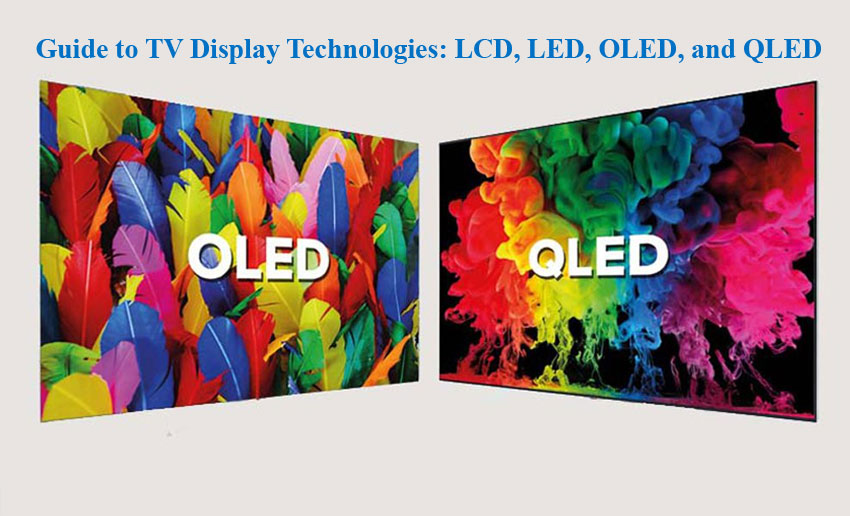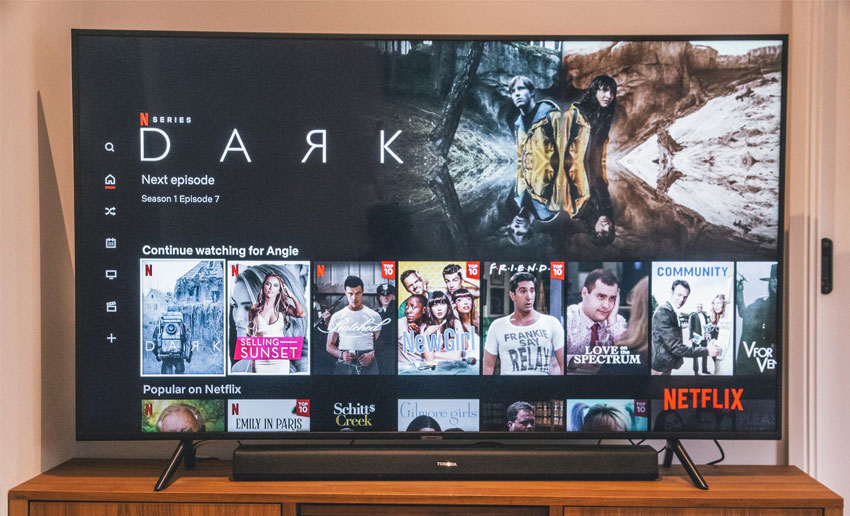A comprehensive comparison of LCD, LED, OLED, and QLED TV display technologies, exploring their features, pros and cons, and how they differ in terms of picture quality, energy efficiency, and cost.

Detailed Overview of LCD Technology
LCD panels utilize liquid crystals to modulate light, providing precise control over brightness and color accuracy. In the past, LCD TVs were typically backlit by CCFLs (Cold Cathode Fluorescent Lamps), but the industry has shifted towards LED-backlit LCDs for improved energy efficiency and enhanced brightness levels. One of the advancements in newer LCD models is the incorporation of local dimming technology, which dynamically adjusts backlight zones to enhance contrast ratios.
For example, consider a scenario where you are watching a movie on an LED-backlit LCD TV. The local dimming technology in the TV allows for deeper blacks in dark scenes and brighter highlights in bright scenes, creating a more immersive viewing experience with enhanced contrast.
LCD technology has undergone significant advancements over the years, with manufacturers constantly improving the performance and features of LCD panels. The transition from CCFL backlighting to LED backlighting has not only enhanced energy efficiency but also contributed to better overall picture quality. Additionally, innovations like quantum dot technology have been incorporated into some LCD displays to further enhance color accuracy and brightness levels, providing consumers with a wider range of options when choosing a TV that suits their preferences and viewing habits.
In-Depth Exploration of LED Technology
LED TVs are well-known for their slim design and energy efficiency, with LED backlighting consuming less power compared to the older CCFL technology. Full-array LED backlighting is a key feature in many LED TVs, providing better control over brightness and contrast levels by dimming specific zones on the screen. Furthermore, Quantum Dot technology, found in some LED displays, enhances color accuracy by filtering light through nanocrystals, resulting in vibrant and lifelike colors.
To illustrate, imagine watching a nature documentary on a full-array LED TV with Quantum Dot technology. The precise control over brightness and color accuracy due to the Quantum Dots would showcase the vivid colors of the landscapes and wildlife, providing a visually stunning viewing experience.
LED technology has revolutionized the television industry by offering superior energy efficiency compared to traditional LCD TVs. With LED backlighting, these displays consume less power, making them an eco-friendly choice for environmentally conscious consumers. Manufacturers have also improved LED TVs’ brightness levels and color reproduction capabilities, ensuring that viewers can enjoy rich and immersive visual experiences without compromising on energy savings.
 Extensive Analysis of OLED Technology
Extensive Analysis of OLED Technology
OLED technology stands out for its unique feature where each pixel in the display emits its light, allowing for true blacks and infinite contrast ratios. This characteristic results in exceptional picture quality with vibrant colors and sharp details. OLED TVs are also known for their fast response times, making them ideal for gaming and viewing fast-moving content. Additionally, OLED displays are thinner and lighter than traditional LCDs, offering flexibility in terms of design and installation options.
For instance, when watching a sci-fi movie on an OLED TV, the individual pixel illumination would showcase the deep blacks of outer space and the bright colors of futuristic technology with stunning clarity and contrast.
OLED technology has set a new standard for TV displays with its ability to produce true blacks and unmatched contrast ratios. The self-emissive nature of OLED pixels eliminates the need for backlighting, allowing each pixel to independently emit light, resulting in incredibly sharp and detailed images. Furthermore, OLED displays offer wider viewing angles and faster response times compared to traditional LCD panels, ensuring that viewers can enjoy consistent picture quality from various positions within a room.

Thorough Examination of QLED Technology
QLED displays utilize Quantum Dots to enhance color accuracy and brightness levels, providing a wider color gamut compared to standard LED TVs. Samsung’s QLED TVs feature innovative technologies such as Ultra Viewing Angle for improved off-axis viewing and Adaptive Picture for optimized brightness in different lighting conditions. Moreover, QLED TVs are compatible with HDR formats like HDR10+ and Dolby Vision, delivering enhanced contrast and color depth for a more immersive viewing experience.
For example, if you were watching a sports event on a QLED TV with Ultra Viewing Angle technology, you would experience consistent and vivid colors even from the sides of the TV, ensuring a high-quality viewing experience for everyone in the room.
QLED technology represents a significant advancement in the TV industry, offering consumers a balance between premium picture quality and affordability. By incorporating Quantum Dot technology, QLED displays can achieve brighter and more accurate colors, making them ideal for vibrant and dynamic content. Additionally, features like Ultra Viewing Angle and Adaptive Picture enhance the overall viewing experience by ensuring consistent brightness levels and color accuracy across different viewing conditions, catering to a wide range of user preferences and environments.
Pros and Cons of LCD Displays
LCD displays offer a cost-effective solution for consumers looking to purchase a new TV without breaking the bank. For example, a 65-inch LCD TV can be significantly cheaper than its OLED or QLED counterparts, making it a practical choice for budget-conscious buyers. This affordability factor has contributed to the widespread popularity of LCD TVs in the market.
One of the drawbacks of LCD technology is its limited viewing angles and color accuracy, especially when compared to OLED and QLED displays. For instance, when viewing an LCD TV from an extreme angle, the image quality may deteriorate, leading to color distortion and reduced contrast. This limitation can impact the overall viewing experience, particularly in larger rooms where viewers may not be directly in front of the screen. Despite this drawback, LCD TVs remain a preferred choice for many consumers due to their reliability and adaptability to different lighting conditions. Their versatility makes them suitable for use in various environments, from bright living rooms to dimly lit bedrooms, offering a practical solution for everyday entertainment needs.
LCD TVs have evolved over time to address some of the limitations associated with traditional LCD displays. The transition from CCFL backlighting to LED backlighting has significantly improved energy efficiency and brightness levels, resulting in a more environmentally friendly and visually appealing viewing experience. Additionally, advancements in local dimming technology have enhanced the contrast ratios of LCD models, allowing for deeper blacks and brighter highlights in on-screen content. These improvements have made LCD TVs a competitive choice in the market, offering consumers a reliable and cost-effective option for their entertainment needs.
Advantages and Limitations of LED Displays
LED technology has revolutionized the television industry by offering superior energy efficiency compared to traditional LCD TVs. With LED backlighting, these displays consume less power, making them an eco-friendly choice for environmentally conscious consumers. For instance, a 55-inch LED TV uses approximately 60-80 watts of power, while a similar-sized LCD TV can consume around 150-200 watts, resulting in significant energy savings over time.
Despite their energy efficiency, some LED displays may encounter uniformity issues that affect picture quality. Clouding and flashlighting are common problems where certain areas of the screen may appear brighter than others, impacting the overall viewing experience. Manufacturers have been addressing these issues through advancements in technology, such as local dimming features, to improve contrast ratios and minimize uniformity issues for a more enjoyable viewing experience.
Moreover, the use of LED backlighting in TVs allows for sleeker and more stylish designs. LED TVs are known for their slim profiles, enabling manufacturers to create thinner displays that are aesthetically pleasing and complement modern home decor. Additionally, edge-lit LED displays offer flexibility in installation options, allowing users to mount their TVs flush against the wall or in tight spaces where traditional TVs might not fit comfortably, providing a seamless and customized viewing experience.
LED displays have become increasingly popular due to their energy-efficient operation and sleek design aesthetics. The transition from CCFL to LED backlighting has not only reduced power consumption but also improved overall picture quality, making LED TVs a preferred choice for many consumers. Additionally, advancements in LED technology, such as local dimming and Quantum Dot filters, have further enhanced color accuracy and brightness levels, ensuring that viewers can enjoy vivid and lifelike images on their screens. These features, combined with the slim form factor of LED TVs, make them a versatile and attractive option for modern home entertainment setups.
 Benefits and Drawbacks of OLED Displays
Benefits and Drawbacks of OLED Displays
OLED technology offers several advantages that contribute to its reputation for exceptional picture quality. One significant benefit is the ability of OLED displays to produce true blacks, thanks to the self-emissive nature of each pixel. This feature results in an infinite contrast ratio, where black areas of the screen are truly dark without any light bleeding from adjacent pixels. This capability not only enhances image depth but also makes colors appear more vibrant and lifelike, providing viewers with a more immersive visual experience. For example, when watching a nighttime scene in a movie on an OLED TV, the dark areas will be pitch black, allowing bright elements to stand out vividly, creating a striking contrast that adds to the overall realism of the content.
Moreover, OLED technology’s fast response times make it particularly well-suited for displaying fast-moving content such as action movies or sports events. The individual pixel control in OLED displays enables each pixel to switch on or off independently, leading to minimal motion blur and smoother transitions between frames. This feature ensures that viewers can enjoy sharp and crisp images even during scenes with rapid movements, enhancing the overall viewing experience. For instance, when watching a high-octane car chase on an OLED TV, the fast-paced action sequences will appear detailed and fluid, without any blurring or smudging that might be present on displays with slower response times.
Despite these benefits, OLED displays are not without their drawbacks. One notable limitation is the potential risk of screen burn-in, especially when static images or logos are displayed on the screen for extended periods. Screen burn-in can occur when certain pixels age faster than others due to prolonged exposure to static content, resulting in a ghost image that remains visible even when the display content changes. While advancements in OLED technology have reduced the likelihood of burn-in through features like pixel shifting and screen savers, users should still exercise caution when displaying static elements for extended durations to mitigate this risk and prolong the longevity of their OLED TVs.
OLED displays have garnered widespread acclaim for their exceptional picture quality and unique features. The self-emissive nature of OLED pixels allows for precise control over individual light sources, resulting in deep blacks and vibrant colors that enhance the overall viewing experience. Additionally, OLED technology’s ability to achieve infinite contrast ratios ensures that images are displayed with remarkable clarity and detail, making OLED TVs a popular choice among discerning consumers. However, concerns regarding screen burn-in and higher manufacturing costs have prompted users to weigh the benefits of OLED displays against these potential drawbacks, emphasizing the need for careful consideration when investing in this advanced technology.
Merits and Demerits of QLED Displays
QLED displays are renowned for their ability to produce bright and vivid colors, making them suitable for well-lit rooms and vibrant content. The incorporation of Quantum Dots in QLED technology enhances color accuracy and brightness levels, allowing for a wider color gamut compared to standard LED TVs. When watching content on a QLED display, viewers can expect to see rich and true-to-life colors that bring images to life with exceptional vibrancy and clarity, creating a captivating visual experience.
However, despite their impressive color reproduction capabilities, QLED displays are susceptible to an optical phenomenon known as blooming. This effect manifests as a halo or glow around bright objects on a dark background, potentially impacting the overall viewing experience. For example, when viewing a scene with bright subtitles on a dark movie backdrop, blooming may cause the text to appear surrounded by a subtle glow, detracting from the intended clarity and sharpness of the image.
Furthermore, QLED technology strikes a balance between affordability and premium picture quality, making it an attractive option for consumers who desire exceptional visual performance without the high price associated with OLED displays. By offering a cost-effective alternative to OLED TVs, QLED models provide an accessible entry point into the realm of high-quality display technologies, catering to individuals who value superior image quality but have budget constraints that limit their investment in more expensive options.
QLED displays have gained popularity for their ability to deliver vibrant colors and high brightness levels, making them an ideal choice for consumers seeking a visually striking viewing experience. The utilization of Quantum Dot technology in QLED displays enhances color accuracy and saturation, ensuring that images are displayed with lifelike vibrancy and clarity. Additionally, features like Ultra Viewing Angle and Adaptive Picture technology further enhance the overall viewing experience by providing consistent brightness and color performance across various viewing conditions, catering to diverse user preferences and environments. While issues such as blooming may occur in QLED displays, advancements in technology continue to refine and improve the visual quality of these TVs, offering consumers a compelling blend of performance and affordability in the competitive TV market.
Comparison of Picture Quality, Energy Efficiency, and Cost
When comparing picture quality, OLED TVs stand out for their exceptional performance, providing viewers with true blacks, vibrant colors, and a more immersive viewing experience. For instance, LG’s OLED TVs are renowned for their infinite contrast ratios due to each pixel’s ability to generate its light source, resulting in unparalleled picture quality and stunning visuals. This technology ensures that dark scenes are displayed with remarkable detail and depth, making OLED displays ideal for movie enthusiasts and gamers alike.
In terms of energy efficiency, LED TVs take the lead by consuming less power than both traditional LCDs and OLEDs, making them an attractive option for eco-conscious consumers seeking long-term energy savings. For example, Samsung’s LED TVs are designed to be energy-efficient without compromising on performance, offering users a greener alternative without sacrificing picture quality. The use of LED backlighting not only reduces power consumption but also contributes to the slim and sleek design of modern LED TVs, enhancing their aesthetic appeal.
Moreover, when considering cost-effectiveness, QLED displays present a compelling choice for consumers looking to strike a balance between picture quality and affordability. Samsung’s QLED TVs, for instance, leverage Quantum Dot technology to deliver bright and vivid colors, catering to those who desire high-performance displays at competitive prices. By offering features like Ultra Viewing Angle and Adaptive Picture technology, QLED TVs provide an enhanced viewing experience without the premium price tag associated with OLED models. This makes QLED TVs a popular option for individuals seeking a cost-effective yet impressive visual solution for their entertainment needs.
The comparison of picture quality, energy efficiency, and cost among LCD, LED, OLED, and QLED displays highlights the unique strengths and characteristics of each technology. While OLED TVs excel in delivering superior picture quality with true blacks and vibrant colors, LED TVs are highly energy-efficient, making them a practical choice for long-term energy savings. On the other hand, QLED displays strike a balance between picture quality and affordability, appealing to consumers looking for high-performance TVs at competitive prices. LCD TVs, known for their budget-friendly options, remain a reliable choice for those prioritizing cost-effectiveness without compromising essential features like screen size and resolution. By understanding the distinct advantages of each TV display technology, consumers can make informed decisions based on their preferences and viewing requirements, ensuring an optimal viewing experience tailored to their needs.